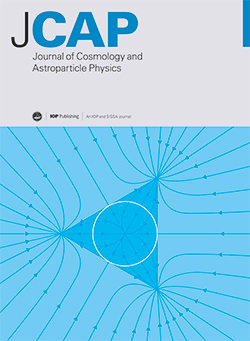Non-locality in quadrupolar gravitational radiation
IF 5.9
2区 物理与天体物理
Q1 ASTRONOMY & ASTROPHYSICS
Journal of Cosmology and Astroparticle Physics
Pub Date : 2025-02-25
DOI:10.1088/1475-7516/2025/02/049
引用次数: 0
Abstract
General Relativity suffers for two main problems which have not yet been overcome: it predicts spacetime singularities and cannot be formulated as a perturbative renormalizable theory. In particular, many attempts have been made for avoiding singularities, such as considering higher order or infinite derivative theories. The price to pay in both cases is to give up locality and therefore they are known altogether as non-local theories of gravity. In this paper, we investigate how to recognize the presence of non-local effects by exploiting the power emitted by gravitational waves in a binary system in presence of non-local corrections as R□-1R to the Hilbert-Einstein action. After solving the field equations in terms of the source stress-energy tensor Tμν and obtaining the gravitational wave stress-energy pseudo-tensor, Tμν, we find that the General Relativity quadrupole formula is modified in a non-trivial way, making it feasible to find a possible signature of non-locality. Our final results on the gravitational wave stress-energy pseudo-tensor could also be applied to several astrophysical scenarios involving energy or momentum loss, potentially providing multiple tests for non-local deviations from General Relativity. We finally discuss the detectability of the massless transverse scalar mode, discovering that, although this radiation is extremely weak, in a small range around the model divergence, its amplitude could fall within the low-frequency Einstein Telescope sensitivity.四极引力辐射的非定域性
广义相对论有两个尚未解决的主要问题:它预测时空奇点,不能作为一个微扰重整化理论公式化。特别是,许多尝试都是为了避免奇点,例如考虑高阶或无限导数理论。在这两种情况下付出的代价都是放弃定域性,因此它们都被称为非定域性引力理论。在本文中,我们研究了如何识别非局部效应的存在,通过利用引力波在存在非局部修正的双星系统中发射的能量作为希尔伯特-爱因斯坦作用的R□-1R。通过求解源应力-能量张量Tμν的场方程,得到引力波应力-能量伪张量Tμν,我们发现广义相对论四极子公式得到了非平凡的修正,使得寻找可能的非局域性特征成为可能。我们关于引力波应力-能量伪张量的最终结果也可以应用于涉及能量或动量损失的几种天体物理场景,可能为广义相对论的非局部偏差提供多种测试。我们最后讨论了无质量横向标量模式的可探测性,发现尽管这种辐射非常微弱,在模型散度附近的小范围内,其振幅可以落在低频爱因斯坦望远镜的灵敏度范围内。
本文章由计算机程序翻译,如有差异,请以英文原文为准。
求助全文
约1分钟内获得全文
求助全文
来源期刊

Journal of Cosmology and Astroparticle Physics
地学天文-天文与天体物理
CiteScore
10.20
自引率
23.40%
发文量
632
审稿时长
1 months
期刊介绍:
Journal of Cosmology and Astroparticle Physics (JCAP) encompasses theoretical, observational and experimental areas as well as computation and simulation. The journal covers the latest developments in the theory of all fundamental interactions and their cosmological implications (e.g. M-theory and cosmology, brane cosmology). JCAP''s coverage also includes topics such as formation, dynamics and clustering of galaxies, pre-galactic star formation, x-ray astronomy, radio astronomy, gravitational lensing, active galactic nuclei, intergalactic and interstellar matter.
 求助内容:
求助内容: 应助结果提醒方式:
应助结果提醒方式:


